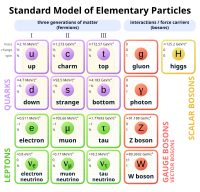
Photo from wikipedia
I discuss the two-flavor Schwinger model both without and with fermion masses. I argue that the phenomenon of "conformal coalescence," in unparticle physics in which linear combinations of short-distance operators… Click to show full abstract
I discuss the two-flavor Schwinger model both without and with fermion masses. I argue that the phenomenon of "conformal coalescence," in unparticle physics in which linear combinations of short-distance operators can disappear from the long-distance theory, makes it easy to understand some puzzling features of the model with small fermion masses. In particular, I argue that for an average fermion mass m_{f} and a mass difference δm, so long as both are small compared to the dynamical gauge boson mass m=esqrt[2/π], isospin-breaking effects in the low-energy theory are exponentially suppressed by powers of exp[-(m/m_{f})^{2/3}] even if δm≈m_{f}. In the low-energy theory, this looks like exponential fine-tuning, but it is done automatically by conformal coalescence.
Journal Title: Physical review letters
Year Published: 2020
Link to full text (if available)
Share on Social Media: Sign Up to like & get
recommendations!